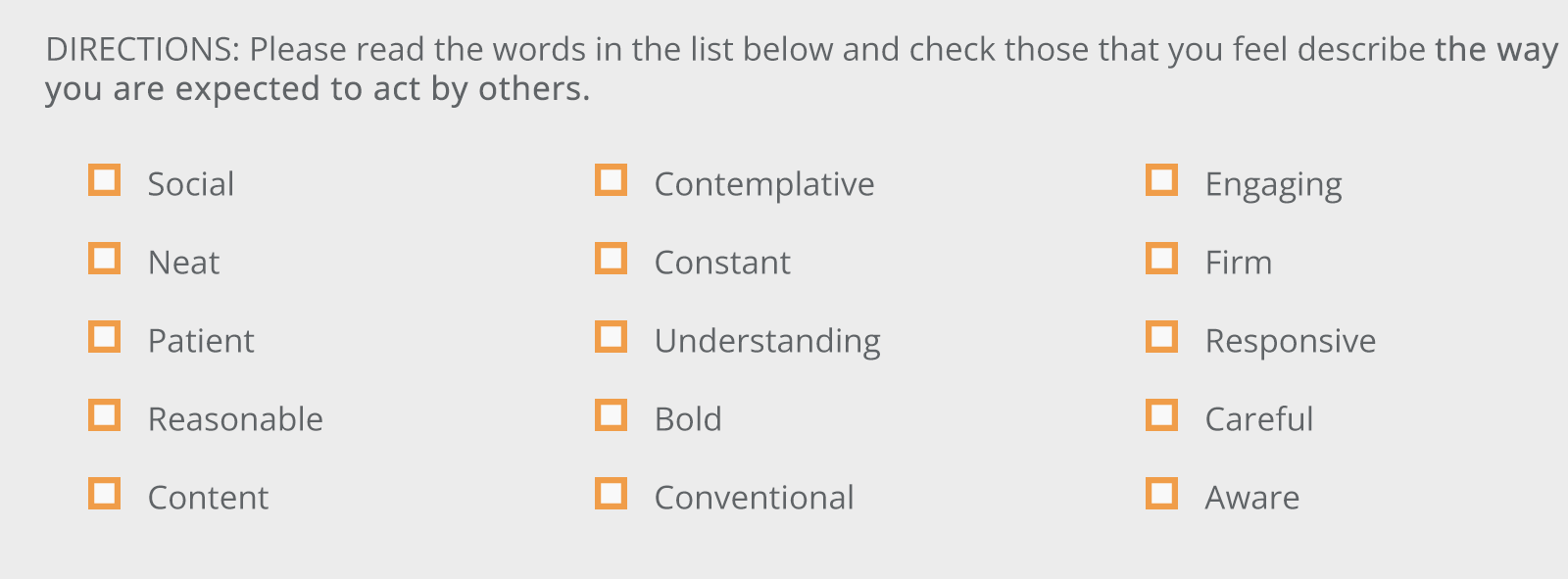Predictive Index Tests – A 2026 Guide
Updated November 6, 2024
Predictive Index (PI) is an organization that offers a range of psychometric testing and workforce assessment solutions.
The Predictive Index tests have been designed to reveal information on cognitive ability and to find out the driving forces behind how an individual is likely to behave and perform within the workplace.
What Are Predictive Index Tests?
Predictive Index is a US company founded in 1955 that creates a number of tests for use in employment.
Arnold Daniels, the founder, first discovered psychometric testing as a successful flight navigator in World War II. He was so taken with the insights, that when he left the Air Force, he went to Harvard to study psychology.
PI tests are known for being business-relevant, well-established and scientifically proven measures of behavioral tendencies in the workplace. They are designed to offer objective, bias-free tests of cognitive ability and personality as part of the recruitment process, to help manage teams, and to help employees develop.
The two most popular tests are the Predictive Index Cognitive Assessment (PICA) which measures abstract intelligence, and the Predictive Index Behavioral Assessment (PIBA) which looks at characteristics related to personality.
When Are Predictive Index Tests Used?
Both the PICA and the PIBA are often used in the early stages of the hiring process because they are simple to distribute to a number of candidates and provide a straightforward way to reduce a candidate pool.
Personality Index tests are usually used for graduate roles, but they can be found throughout all industries and roles at every level.
Businesses choose the Predictive Index tests because they have been validated through hundreds of studies. The tests were developed based on psychological standards and guidelines from the likes of the American Psychological Association (APA), the International Test Commission (ITC) and the Society for Industrial and Organizational Psychology (SIOP).
More than 25 million people around the world have been assessed using PI, and with 383 validity studies completed, they are a popular choice for both big and small organizations globally.
List of Companies That Use Predictive Index Tests
Companies that use the Predictive Index tests as part of their employment process include:
- IKEA
- Dell
- Microsoft
- Meridian
- Subway
- IBM
- Nissan
- Canon
- Chevron
- DocuSign
Practice Predictive Index Test with JobTestPrep
Predictive Index Cognitive Assessment
One of the most popular tests is the Predictive Index Cognitive Assessment (PICA).
What Does the Test Measure?
The PICA is an aptitude test designed to remove bias from the selection process by presenting candidates with a number of questions to challenge abstract intelligence.
The way you answer the questions will demonstrate how quickly you can learn, how you make decisions and how well you can adapt to different situations – all under pressure.
According to Predictive Index, cognitive ability is the number one predictor of job performance. Employers can set a benchmark score and immediately discount all those who do not attain it.
The objective nature of the questions offers candidates an opportunity to demonstrate that they have the ability to process complex information and therefore deal with the mental demands of the role.
If you are taking a PICA for a role, getting as high a score as possible is important, as it is mostly used as a sifting tool early in the recruitment process. A low score may mean you don’t pass to the next stage.
PICA Test Format and Free Sample Questions
The PICA is considered a challenging ability assessment, mainly because of the short time allowed to answer the questions. There are 50 questions and you have 12 minutes – a rate of over four questions per minute.
The questions are a combination of verbal, numerical and abstract reasoning questions, and while you need no previous knowledge to complete them, good practice can help you to answer the questions quickly and improve your score.
Practice the Predictive Index Test
Verbal Reasoning
Verbal reasoning tests your ability to quickly read, understand and analyze a passage of text to find an answer. The PICA verbal reasoning questions assess your knowledge of antonyms, analogies and analysis, and you will select one of three answers.
For example, verbal reasoning questions might be presented as a series of statements and you will need to find the logical answer.
- Boys prefer football to reading
- Girls prefer reading to football
- No girls like football
Is the final statement:
a) Correct
b) Incorrect
c) Cannot be determined
Other questions might ask you to choose the correct antonym for a given word or choose the right analogy for a given passage. Although many candidates may find the verbal reasoning questions the easiest kind of question, you will find it easier to locate the answer in the text and work faster if you have practiced.
Numerical Reasoning
In numerical reasoning questions, you will be presented with some data, in the form of numbers, charts or graphs, which you need to analyze and interpret to find the right answer. There are three types of numerical reasoning questions: lowest value, series and number problems.
These questions are multiple choice, and you will not be able to use a calculator to complete them – so practicing numerical reasoning questions is important to find ways to speed up your calculations.
For example, you might be presented with a number problem like this one:
Andrew has to complete 180 hours of volunteering work before the summer. To make it easier, he has decided to do 50% of them this month.
How many days would he be volunteering this month if he did 6 hours a day?
a) 7
b) 22
c) 15
d) 19
Abstract Reasoning
In abstract reasoning questions, you will need to find patterns in a series of images and shapes to deduce the answer. You will be tested on finding the next in the series, the odd one out or looking for analogies.
These questions are multiple choice, and you need to work out the logical answer when following the pattern.

(Source: Predictive Index)
Identify the next in the sequence.
How is the Predictive Index Test Scored
The Predictive Index Cognitive Assessment is marked out of 50. You are not expected to get a full score but aiming high is always best as the employer will have a set score that you need to ‘beat’ in order to be approved.
The test score is presented on a scale between 100 and 450, with the average being 250 (equating to about 20/50 as a raw score). There are no negative marks for wrong answers.
According to Predictive Index, a score of the employer-set target +2 makes you a complete cognitive fit for the role that you are applying for. To ensure you can achieve the score you need for the role, it is best to aim high, practice well and answer as many questions as you can in the allocated time.
How to Pass the PICA in 2026
Step 1. Know What to Expect
The hardest part of the Predictive Index Cognitive Assessment is the short time allocated for each question.
If you are fully aware of what is to come, by understanding what numerical, verbal and abstract reasoning questions are and how to answer them, you will be more prepared when facing them in the test.
Step 2. Practice
Although the Predictive Index Cognitive Assessment is testing abstract intelligence and cognitive ability so does not need any specialised knowledge, it is a challengingly short test and therefore practice can make a real difference.
There are several websites providing free and paid-for practice questions specifically for Predictive Index assessments.
For general practice on the different types of cognitive ability tests, you can find numerical reasoning, abstract reasoning, and verbal reasoning tests on JobTestPrep’s site that will give you more practice on different questions.
You can also find PICA preparation packs at JobTestPrep, which include practice tests as well as tips, tricks and shortcuts to help you improve your speed.
Try the practice assessments under test conditions (set a timer for 12 minutes) and work on improving your time and the number of questions you can answer.
Step 3. Focus Your Practice
Keep practicing but focus most intention on the areas you feel are weaker. Focused practice on the types of questions that take you longer will help you to create a reliable method to provide a shortcut for you.
Increasing your speed on all the question types will help make sure that you get a higher score overall.
Step 4. Learn Solving Strategies
Solving strategies are methods that can be used to speed up the completion of a question.
With prep packs, not only will you get a number of practice tests to see where you need to improve, but you will also receive some tried and tested shortcuts to use to decide which method suits you best.
Step 5. Elimination
Elimination is a great way to improve speed on a multiple-choice test. By disregarding answers that cannot be correct, you are left with fewer possibilities and can narrow your focus.
When you are faced with a question for which you can ‘guess’ what the answer won’t be, you can take away those answers and leave yourself with fewer options. This is especially useful in reasoning tests where there is often at least one obviously wrong answer.
Step 6. Prepare Yourself
The night before the test, make sure that you get a good night’s sleep and are well rested. Eat a decent breakfast and stay hydrated to give yourself the best chance of success.
A good diet, plenty of water and being well rested improves cognitive function and will set you up for a better test performance.

If you need to prepare for a number of different employment tests and want to outsmart the competition, choose a Premium Membership from JobTestPrep.
You will get access to three PrepPacks of your choice, from a database that covers all the major test providers and employers and tailored profession packs.
Predictive Index Behavioral Assessment
What Does the Test Measure?
The Predictive Index Behavioral Assessment is a tool to help employers understand the personality traits of a prospective or existing employee. They allow recruiters to hire candidates that are a great fit, to create high-performing teams, and to use personality and behavior to help train and push staff to become great.
The Predictive Index Behavior Assessment translates the answers to the test into a behavioral pattern that can be used by employers to help them understand how the candidate likes to work. This can also be used by the candidate themselves for self-discovery.
The test is designed to measure four factors, also known as ‘drives’ or ‘motivating needs’. Each person is a combination of these drives in varying amounts, and the PIBA is a good indication of how a candidate behaves at work.
Dominance
The level of Dominance that someone displays is about how much influence they like to exert on people and events.
Sometimes known as the ‘A Drive’, people with a high Dominance factor are independent and assertive, enjoy working autonomously and are self-confident.
Candidates with low Dominance might be seen as more cooperative and collaborative, preferring teamwork and happy to go along with what other people are doing.
Extraversion
On the Extraversion scale, candidates will have a preference for social interaction with other people. Extraversion is sometimes known as the B Drive.
Those with a low Extraversion drive will value their privacy and enjoy working with facts and their own imagination.
High Extraversion candidates are outgoing and connect easily with others, seeking social acceptance through enthusiasm.
Patience
Sometimes known as the C Drive, Patience describes the drive for consistency and stability.
Those with a high Patience factor need a work environment that is stable and they like to work at a steady pace. They are often patient, calm and peaceful.
Low Patience candidates enjoy variety, work quickly and are adept at juggling multiple priorities. They can be described as intense and restless.
Formality
The Formality or D Drive is the factor that shows how a candidate reacts to rules and structure.
Those with a high Formality drive are likely to prefer working with clear expectations and enjoy becoming a subject expert. They are usually well-disciplined and thorough, and may be described as meticulous.
Candidates with a low Formality factor like working in a free-structure environment with fewer limits and controls, and are flexible and spontaneous. They prefer to delegate the details in favor of the bigger picture.
Format
The PIBA is a free-choice, untimed test. There is no official time limit, but it generally takes 5–10 minutes to complete. Candidates can select as many (or as few) answers as they want, which is known as a stimulus-response tool.
You will receive two pages of 86 adjectives.
The first page of adjectives is how you think others expect you to act and what adjectives they would choose if filling this out about you.
The second page is about describing yourself.
The test allows you to decide whether to select the adjective (or not) and there is no limit to the number of words you can select. Some of the adjectives may be synonyms for each other or seem like they are describing the same trait – you need to select as many as you think apply.
Practice PI Behavioral Assessment

(source: Predictive Index)
You can select every one of the adjectives that you think fit the way you are expected to act by others.
Test Scoring
The results of this test are not ‘scored’ in a traditional way. They are translated into a behavioral profile that the recruiter or employer will use to compare against the needs of the business.
The ‘reference profile’ is a snapshot of the way the candidate thinks and works and is not relevant to any particular job role – it is personality- and behavior-based. There is no pass or fail; the employers will be looking for specific behaviors, and if you don’t have them, then you aren’t the best fit for the role.
There are 17 reference profiles used to describe candidates following the PIBA, and these are descriptive rather than prescriptive.
Analytical Profiles
- Analyzer – Demands details, collects facts to form a decision
- Controller – Gets things done correctly, fast-paced, self-disciplined
- Venturer – Pushes boundaries and drives forward
- Specialist – Introspective, loyal to authority
- Strategist – Big picture, looks towards the future
Social Profiles
- Altruist – Accurate and supportive, helpful
- Captain – Strong will, independent
- Collaborator – Patient, empathetic, cooperative
- Maverick – Visionary with high aspirations, usually in leadership
- Promoter – Charismatic and popular
- Persuader – Motivator, doesn’t take no for an answer, well-spoken
Stabilizing Profiles
- Adapter – Typical generalist, takes on all kinds of roles
- Craftsman – Reliable worker, listens more than talk
- Guardian – Precision and structure
- Operator – Informal, reliable, and relaxed
Persistent Profiles
- Individualist – Analytical and persistent, strong-minded and confident
- Scholar – Reserved and knowledgeable
Key Tips for PIBA
Understand What the Test Is Measuring
Be aware of the personality traits that are being measured. Think about where you would place yourself on the scales of Dominance, Extraversion, Patience and Formality. The adjectives used in the PIBA are based on these drives.
Understanding the drives and why they are being measured will help you feel more prepared when answering the questions.
Research the Company
When you apply for a role, you should be completing research about it to make sure that the company is a place where you want to work, and the role is a good fit.
As part of this research, you can find out more about the type of people who already work there as well as the company values, and use this to inform your selections.
Answering Honestly Is Important
Although you might want to answer in the way that you think will impress the company or recruiter, don’t be tempted to ‘fake it’. It is as important that the role is a good fit for you as it is that you are a good fit for the role. Trying to manipulate the PIBA to ‘game’ the test and get the right answers could be career self-sabotage.
Don’t forget that the employer will use Predictive Index assessments alongside other hiring processes like interviews and resumes, so they are not necessarily the only way your application will be assessed.
If you are taking the Predictive Index Behavioral Assessment as part of your employment, either as a training exercise or part of a promotion, then answering honestly will help your manager to find the right way to help you grow, develop and work more effectively.
Be Consistent
Consistency is key – and is also why honesty is important. Be as honest as you can in your answers because there will be a number of words that mean broadly the same thing.
This is why a free-choice assessment is arguably harder to fake than a forced-choice assessment, and why a recruiter or employer is more likely to notice when the answers don’t add up.
Avoid Too Many ‘Strong’ Adjectives
You might want to consider limiting the number of extreme adjectives you choose in order to meet the behavioral targets the company is looking for. Remember the tips above about being honest and answering truthfully for the best results.
Prepare Yourself
Although this is not an exam-style assessment, the PIBA should still be treated as a test – and that means the preparation should be similar.
While you can’t practice for a better score, you can make sure that you give your brain the best fuel through adequate rest, hydration and food. Get a good night’s sleep, eat a hearty meal and drink plenty of fluids before the assessment.
Frequently Asked Questions
Each employer sets a target score for the Predictive Index test. The test itself is marked out of 50 to create a raw score, which is then translated onto a scale between 100 and 450.
The average scaled score is 250, which equates to answering around 20 questions correctly. To be a good cognitive fit for an organization or job role, Predictive Index suggests candidates should aim to score at least two points higher than the employer’s target score.
The Predictive Index test is a type of aptitude test. It was designed to help eliminate bias from the selection process. It tests abstract intelligence in a pressurised environment, with a candidate’s answers showing how fast they can learn, their decision-making style and their ability to adapt to new or challenging situations.
Predictive Index says that cognitive ability is the number one predictor of job performance, so the predictive index test gives an employer insight on how you will perform if selected for employment.
Your raw score is used to create a scaled score based on how many questions you answer correctly. You will not lose points for answering a question incorrectly, so the more questions you get right, the higher your score will be.
Your scaled score will fall between 100 and 450, with the average candidate scoring 250 – this equates to around 20 correct answers. Each employer sets its own target score, and your scaled score will be used to compare your performance against other candidates.
It will also be used to create a Reference Profile – this is designed to provide an overview of how you think and how you are likely to work.
The Predictive Index cognitive test is a type of personality test. It is used by employers to gain insight into cognitive ability and how well a candidate is likely to fit into the company and job role.
Employers use the PICA to find out how fast a prospective employee will pick up new skills if they are recruited. It can also be used to highlight candidates with the level of cognitive ability required to excel in a particular job role.
The predictive index looks for a candidate’s behavioural drives (Dominance, Extraversion, Formality and Patience) and cognitive ability. A candidate’s Predictive Index results are used to help employers make objective hiring decisions when recruiting new staff or considering existing staff for promotion.
Factor E is used to establish a candidate’s decision-making style. A high ‘E’ score indicates that a candidate is likely to be an objective decision-maker. They will seek to investigate facts and use data to inform their decisions. A low ‘E’ score suggests that the candidate is likely to be a subjective decision-maker. They might tend to rely on gut feelings, rather than searching for facts and information.
Employers use Predictive Index tests to gain a better understanding of how a prospective employee is likely to behave in the workplace and whether they are suitable for a particular job role. Employers use Predictive Index tests for new recruits as well as existing employees seeking opportunities for promotion or growth
Conclusion
The Predictive Index range of assessments are trusted indicators of performance in role and offer employers an opportunity to quickly sift through a large talent pool when recruiting. Useful for employees both already in post and new hires, the Predictive Index Cognitive Assessment and the Predictive Index Behavioral Assessment are tools that can provide an objective snapshot of the abilities, motivators and drives of the candidate.
To perform at your best for the PICA, practice is necessary. The test is difficult because there are a lot of questions to be answered in a short space of time – and this pressure means it is unlikely that you will be able to answer all the questions. The average score for the PICA is about 20/50, so aim high for the best chance to get through to the next round in the application process.
With the PIBA, employers are looking for the way you behave in work and to understand your personality traits. There is no need to practice for this test but do remember to be honest. It might be tempting to try and answer in the way you think the employer wants you to, but that is likely to make the results unhelpful and could end up with you getting the role but being unsuitable for it or the environment. Being truthful in the assessment can help you discover more about yourself and the way you like to work, even if you don’t end up progressing further in the role.
As developmental tools, both the PICA and the PIBA can help to improve teamwork and develop individual employees according to their skill sets.






